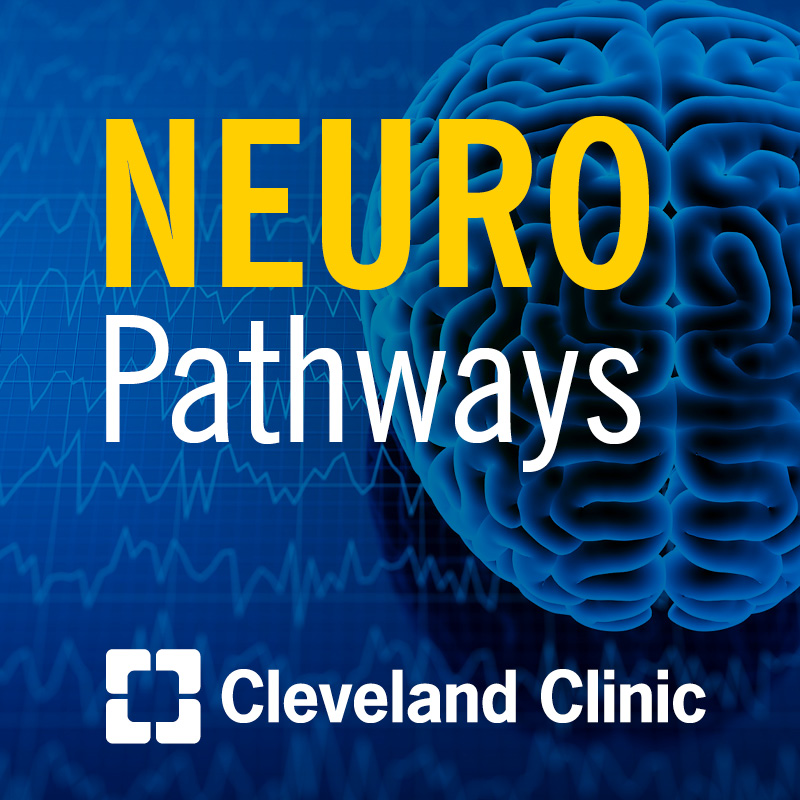Pancreatic Neuroendocrine Tumors

On this episode of Butts & Guts, Mayank Roy. MD, gastrointestinal surgeon, surgical director of the Pancreas Center, and program director of Education & Robotic Surgery at the Digestive Disease Institute (DDI) at Cleveland Clinic Florida, explores pancreatic neuroendocrine tumors (pancreatic NETs). Listen in to learn how pancreatic NETs differ from other types of pancreatic cancer.
Subscribe: Apple Podcasts | Podcast Addict | Spotify | Buzzsprout
Pancreatic Neuroendocrine Tumors
Podcast Transcript
Scott Steele: Butts & Guts, a Cleveland Clinic podcast exploring your digestive and surgical health from end to end.
Scott Steele: Hi again, everyone, and welcome to another episode of Butts & Guts. I'm your host, Scott Steele, the president of main campus here at Cleveland Clinic, in beautiful Cleveland, Ohio, and colorectal surgeon. I am very pleased today to welcome Dr. Mayank Roy, a gastrointestinal surgeon and the surgical director of the Pancreas Center and program director of Education and Robotic Surgery at the Digestive Disease Institute at Cleveland Clinic, Florida. Mayank, welcome to Butts & Guts.
Dr. Mayank Roy: Dr. Steele, thank you for having me. I'm very excited.
Scott Steele: Great. So today we're going to talk about pancreatic neuroendocrine tumor, but before we get into that, we want to hear a little bit more about your background. Can you tell us a little bit about where you're from, where'd you train, and how did it come to the point that you're at Cleveland Clinic, Florida?
Dr. Mayank Roy: Yes, absolutely. So I was born in India amongst a family of surgeons. I feel I had a subconscious bias towards the medical field because of my family. Did my med school from India. I moved to Europe for a few years for surgical training, and I got an opportunity to do as a research fellow in Cleveland Clinic, Florida. I think since then, the clinic kept pulling me back because of multiple opportunities, great mentors I had throughout. I did my internship in Texas, came back to the clinic to do my residency and fellowship. Went to England to do another fellowship, and then came back again to join the clinic about seven years ago as a staff surgeon.
Scott Steele: So today we're going to be talking a little bit about pancreatic neuroendocrine tumor. So to start, can you explain to our listeners what is a pancreatic neuroendocrine tumor, and how is this different from other types of cancer?
Dr. Mayank Roy: Yeah, I'll take a step back, and I'll talk about neuroendocrine cells. Neuroendocrine cells are present throughout the body. They're present in lungs, helping a regulation of blood flow. They're present in adrenal glands, helping with the flight and fight response. Present in the GI tract, helping digestion. These neuroendocrine cells are also present in pancreas. In pancreas, we have two kind of cells: the exocrine cells, which produce the juice, which helps in digestion of the food; and the neuroendocrine cells, which produces a lot of hormones, most importantly, insulin. These cells can form tumors leading to the pancreatic neuroendocrine tumor.
Dr. Mayank Roy: It's important to differentiate these tumors into two classifications, one is a well-differentiated tumor and one is a poorly differentiated tumor. They act very differently in terms of their behavior. Well-differentiated tumor has a very benign indolent course, whereas a poorly differentiated neuroendocrine tumor can act like a pancreatic adenocarcinoma. In simple analogy, if we think of our body, I guess, as a library with books, and the librarian is putting all these books in the bookshelf. In a well-differentiated tumor, the librarian is mismanaging some of the books, whereas in a well-differentiated tumor, the librarian is mismanaging all the bookshelves so the whole library is a mess. And that's the big difference between those tumors. It's also important to differentiate, pancreatic neuroendocrine tumor is completely separate from pancreatic adenocarcinoma, which most patients know about. They arise from the exocrine glands which produce the juice.
Scott Steele: So how common are pancreatic neuroendocrine tumors, and who is at most risk?
Dr. Mayank Roy: It's not common. Of all the pancreatic tumors arising from the pancreas, they comprise less than 5% of the tumors. Patients in their 50s and 60s are slightly higher risk, also slightly more common in men, patients with diabetes and obese, and some patients with some family history.
Scott Steele: So some of the things we've discussed in the past about pancreatic tumors in general is that they are presenting late, just because of the location of the pancreas or for other reasons. So are there common symptoms and signs that patients should look for, and can these symptoms or signs be mistaken for other conditions?
Dr. Mayank Roy: Yeah, that's an interesting question. These tumors are very indolent in nature. And interesting enough, the most common presentation I see in my clinic, and for that fact, most physicians, is they are picked up incidentally. So patient had a scan for some other reason, in the abdomen, an astute radiology picks up a mass in the pancreas and starts suspecting it as a neuroendocrine tumor. The other way it can present is, just because of the presence of the tumor in the pancreas, it can give you effects of abdominal pain, nausea. And then finally, it can also present because it is unique in a way that it can produce hormones. So pancreatic neuroendocrine tumor can produce certain hormones like insulin, glucagon, and they can lead to symptoms like diarrhea or skin rash. Again, those are very rare presentations. And lastly, I would say, if it is a very aggressive form of pancreatic neuroendocrine tumor, which I mentioned earlier, the poorly differentiated pancreatic neuroendocrine tumor, and if it's present in the head of the pancreas, it can even present with jaundice.
Scott Steele: So are there any other risk factors or even causes associated with pancreatic neuroendocrine tumors?
Dr. Mayank Roy: Yeah, mostly sporadic. Some patients have a family history, and that's a very small percent. So 10 to 20% of patients, patients with family history of MEN syndrome, VHL, neurofibromatosis, they are slightly higher risk of these tumors.
Scott Steele: So how is pancreatic neuroendocrine tumors diagnosed? And what tests can a patient out there listening expect to get if they are suspected of having one?
Dr. Mayank Roy: The key tests are imaging. So most patients are picked up, as I mentioned, incidentally based on a CT or MRI. And these scans have certain features with which we can identify these neuroendocrine tumors. Over the last decade, DOTATATE scan has been a game changer for pancreatic neuroendocrine tumors. If you think of our body as a city of lights, and neuroendocrine tumors have a different kind of glow. In these DOTATATE scans, they're given a certain tracer molecules which goes and attaches to these neuroendocrine tumors, and they glow up, and the radiologist can pick up where exactly these tumors are. And finally, once we know that patient has a neuroendocrine tumor in the pancreas, we can confirm the diagnosis with a biopsy by endoscopy with a needle biopsy. This is sent to pathology, and with the help of special stains such as chromogranin and synaptophysin, we can confirm this as a neuroendocrine tumor.
Scott Steele: So what makes pancreatic neuroendocrine tumor so challenging to detect early? I know we went and kind of hinted around that a little bit, but dig in there, tell me what makes it so hard.
Dr. Mayank Roy: Yeah, absolutely. So in medical community, we use the term functional tumors and non-functional tumors. What it essentially means, functional tumors are the ones which are producing hormones causing symptoms. Non-functional tumors are not producing any hormones. Most of these tumors are non-functional tumors. 80 to 90% of these tumors are non-functional, so they won't be producing any symptoms. Second, they're very indolent and slow growing in their nature. Because of these reasons, either patients do not present with any symptoms, and if they do present with symptoms, it can be very confusing. That's why it's very challenging to detect these tumors.
Scott Steele: So are there any biomarkers or indicators in the blood or elsewhere that would allow for the earlier detection of these neuroendocrine tumors for the pancreas?
Dr. Mayank Roy: So tumors which are producing hormones, for example, insulinoma, we can check for insulin. We have certain biomarkers like chromogranin, which is usually used after surgical resection as a follow-up biomarker. However, at this point we don't have any biomarkers for screening. The only exception is when patients have a known family history. For example, as I mentioned earlier, patients with MEN syndrome, these patients should be screened at an earlier age and with imaging including CT scan and chromogranin, also an endoscopy.
Scott Steele: So what are the current treatment options available for patients diagnosed with these pancreatic neuroendocrine tumors? And can these tumors be cured?
Dr. Mayank Roy: It depends. If the tumors are low-grade tumor, I had mentioned the difference, well differentiated and poorly differentiated, so a low-grade tumor, well differentiated, if it's picked up at an earlier stage and if it is resected completely, then they can have an excellent prognosis and we can consider them as cured. Whereas a higher grade tumor, again, surgery may be an option in those cases, but there, the prognosis may vary a little bit. Now, depending upon the grade and where the tumor is exactly, the treatment options can vary. So a tumor which has gone or metastasized to the liver or other parts of the body, surgical resections still may be an option, but then there are other options which are usually used or added in combination. For example, somatostatin analogs, because these tumors have somatostatin receptors that respond to these somatostatin analogs. Second, we can use chemotherapy, which is very interesting because normally the neuroendocrine tumor do not respond to chemotherapy, whereas pancreatic neuroendocrine tumors are unique that they do respond to chemotherapy. Next, we also use radiotherapy or radioligands for these tumors. And finally, targeted therapy such as everolimus.
Scott Steele: So as a treating physician out there, what factors do you take in to determine that treatment plan for somebody who presents with these tumors?
Dr. Mayank Roy: Pancreatic neuroendocrine tumor depends upon the location of the tumor, which is the key aspect, where exactly it is in the pancreas, the tail of the pancreas, the head of the pancreas, or the body, the functionality of the tumor, if the tumors are producing hormones or not, and if the tumor has metastasized or not, which means if the tumor is just present in the pancreas or has it gone somewhere else, such as the liver. So for a local tumor, we can either just shave it off or resect that portion of the pancreas. For a tumor which has gone somewhere else, for example, the liver, in addition to the resection, liver-directed therapy such as ablation or embolization can be used as well.
Scott Steele: So truth or myth, pancreatic neuroendocrine tumor can be caused by genetic factors, and there is currently a genetic test to help identify these people at the highest risk.
Dr. Mayank Roy: That's the truth. So as I mentioned earlier, it's a very small percent of patients who are affected by genes, but if they do have a family history, they can be screened. For example, MEN syndrome or neurofibromatosis or VHL, also known as Von Hippel-Lindau syndrome. These patients can be tested for certain genetic mutations, and they can be screened appropriately once they're picked up.
Scott Steele: So as a surgeon, can you share any advances in either surgical technique for these neuroendocrine tumors? And then, what does recovery look like from these surgeries?
Dr. Mayank Roy: Yeah, absolutely. Depends upon the size of the tumor and, as I mentioned, location of the tumor. If it's a small tumor sitting on the surface of the pancreas, they can be shaved off. In medical terminology, we call it enucleation. If it's slightly larger tumor, we may have to resect these tumors. When I say resect, we may have to resect that portion of the pancreas. And the way we approach them is either open surgery or minimal invasive surgery. Open surgery is where a patient may require an incision in the abdomen, whereas a minimal invasive surgery will require either laparoscopy or robotic surgery. Robotic surgery is more in the last decade, and it's a platform which makes the surgery more accessible and easier. In terms of recovery, I would say, again, depends upon the approach the patient had, either open or minimal invasive surgery. But in general, patients can expect five to seven days hospital stay, maybe a little longer in certain situations. And then overall, by the time they have a full recovery, they'll probably need about four to six weeks.
Scott Steele: I know you talked a little bit about this, but what is the prognosis for someone diagnosed with a pancreatic neuroendocrine tumor? And I recognize that it depends on is it gone to the liver, is it not, but just kind of an overall sense.
Dr. Mayank Roy: Yeah. If a low-grade tumor, if it has been resected completely, I would say it's an excellent prognosis, almost 80 to 90% five-year survival, even more sometimes. Whereas a higher-grade tumor, the survival can be a little lower. Five-year survival is 40 to 50%. But once again, we have more treatment options over the last 10 years, and the outcome has improved quite a lot.
Scott Steele: So are there any advancements on the horizon when it comes to the treatment of these pancreatic neuroendocrine tumors? Any clinical trials or anything else in the works?
Dr. Mayank Roy:
The field is rapidly changing. Especially over the last 10 years, there have been so many clinical trials which have come up, especially for metastatic neuroendocrine tumor, pancreatic tumors which have gone to the liver, to compare radioligand versus somatostatin versus targeted therapy. The whole goal in these situations is not only to improve survival, but also to make this disease a chronic disease. In a sense, the patients can continue to live with the tumor and the symptoms can be controlled.
Dr. Mayank Roy: A recent ACTION 1 trial is the randomized global trial where it's looking at patients who have not responded to radioligand, which just tells that the community is pushing more and more to improve the outcome for these patients. One thing I would say is, from the surgical perspective, the aggressive tumors which have gone to the liver, we do something called surgical debulking where we try to remove the tumor. In the past, the discussion used to be, if we can remove 90% of the tumor, it's good enough. Now, the goalpost has shifted. If we can remove even 70% of the tumor, we can achieve good outcome in the long term. From the oncologist perspective, they think once the cat is out of the bag, we are not making a huge difference, especially in the high-grade tumor. However, there aren't any randomized controlled trial, and maybe in the future we can have randomized controlled trial comparing surgical debulking of low-grade versus high-grade tumors.
Scott Steele: So now it's time to get to know you a little bit better. It's time for a quick hitter. So first of all, what's your favorite food?
Dr. Mayank Roy: I'm always confused between good Indian and good Mexican food.
Scott Steele: And what is your favorite sport to watch and to play?
Dr. Mayank Roy: It used to be both basketball in the past, but I still watch basketball. But to play, I've gone to low-impact sports: running, biking, and swimming.
Scott Steele: I'm not sure I would classify running as low impact, but I will take that for granted. So what was your first car?
Dr. Mayank Roy: That was a silver Golf.
Scott Steele: And finally, describe yourself in one word.
Dr. Mayank Roy: Oh, that's a tough one. Positive.
Scott Steele: Fantastic. So give us a final take-home message for our listeners surrounding these pancreatic neuroendocrine tumors.
Dr. Mayank Roy: Yeah, I would say these tumors are very unique in the way they present and they have a very indolent and slow growing course. Overall, they have an excellent prognosis, but each individual story is different, and the way they behave and they manage can vary a lot. So all these individuals need a personalized care. They should be managed in a high-volume center where we are dedicated like Cleveland Clinic, where it's not only a surgeon, but an oncologist, radiologist, pathologist, all dedicated towards these patients to give them an individualized care.
Scott Steele: Sound words of advice. So for more information on Cleveland Clinic, Florida, please call 877.463.2010. That's 877.463.2010. You can also visit clevelandclinicflorida.org/digestive for more information. That's clevelandclinicflorida.org/digestive.
Scott Steele: Dr. Roy, thanks so much for joining us here on Butts & Guts.
Dr. Mayank Roy: It was my pleasure. Thank you again for having me.
Scott Steele: That wraps things up here at Cleveland Clinic. Until next time, thanks for listening to Butts & Guts.



